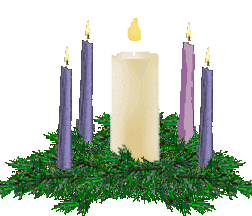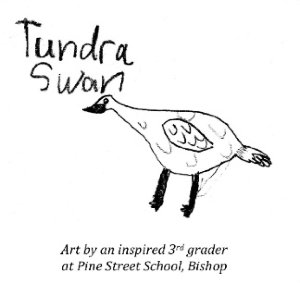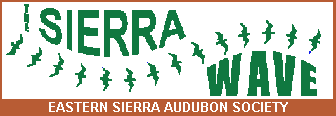
Eastern Sierra Audubon
Sierra Wave Newsletter
Volume 31, Number 2
November-December, 2012
Contents
- Events:
- Features:
- Reports:
- Business
Events
Holiday Potluck Candlelight Dinner and Program, December 5th, 6pm
The December 5th meeting is also our annual Holiday potluck candlelight dinner, held at 6pm in the dining room of the White Mountain Research Station.
Do plan to attend as it is a fun event, and bring a friend or neighbor! Every participant should bring a dish (entrée, salad, or dessert to serve at least 6 people, and contribute either juice, soft drinks, wine or beer to the beverage table.) We often run out of food, so we would appreciate contributions of larger portions so there will be sufficient food for everyone. Please bring your own place setting. Audubon will provide coffee, tea, juice, and a touch of wine prior to the dinner. Arrive by 6pm for our potluck dinner.
The dinner will be followed by a program at 7pm:
30 years of California Gull Research on Mono Lake
(After Holiday Candlelight Dinner - 7pm December 5th)
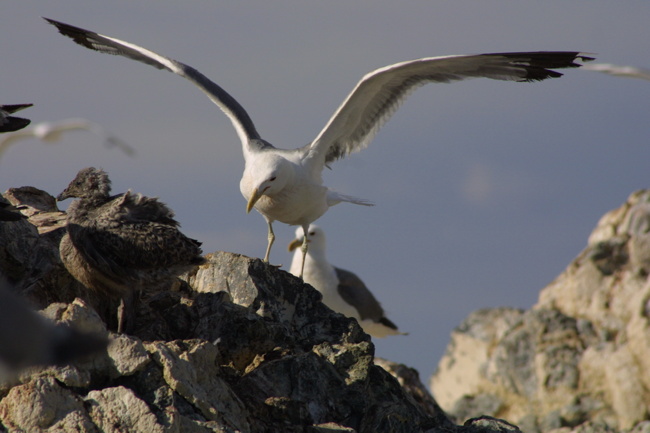
Gulls and chick at Mono Lake
About the Program: The islands of Mono Lake are home to one of the largest nesting colonies of California Gulls in the world. The colony was nearly devastated by human-caused water diversions from Mono Lake, which caused Mono Lake to lose over half its volume and allowed coyotes and other predators access to the gulls’ vulnerable eggs and young. This predation triggered major conservation efforts, legal actions, and media coverage to help “Save Mono Lake” and its California Gulls. Following the predation, the gulls abandoned their historic colony location and relocated to smaller islets on Mono Lake, demonstrating “intelligence” and flexibility. The same year, a handful of pioneering breeders began nesting on salt flats in the San Francisco Bay, establishing the first ever coastal breeding attempts, and beginning a remarkable biological shift for the species. Join Kristie for an overview of PRBO Conservation Science’s 30 years of research on Mono Lake’s gulls, from its involvement in the early days with the fledgling Mono Lake Committee, to exciting discoveries being made today.
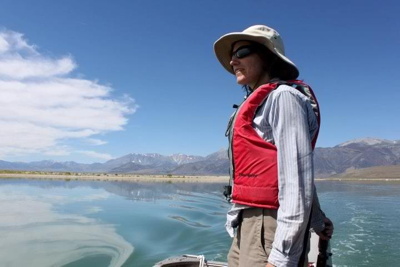
Kristie Nelson out on Mono Lake
About the Speaker: Kristie has had a nearly obsessive love for birds since some of her earliest memories. She has conducted ornithological fieldwork throughout California, and is an active birder and naturalist. She first came to the Eastern Sierra in 2000 working with PRBO Conservation Science, and has remained on the eastside working with PRBO ever since. She has served on the California Bird Records Committee since 2003, and has been the project leader for the California Gull Research Project on Mono Lake since 2005. When not engaged in bird work, she is busy running a small diversified farm with her husband Joel.
For more information contact Jenny Richardson (email jennyn63@gmail.com or call 760-920-8541). Also, check back to this page for updates and the exciting list of speakers for the 2013 season. Everyone is welcome to attend all programs!
Future Programs to look forward to (schedule subject to change):
- February 6, 2013 - Matthew Matthiessen: Birds of Peru or Cuba
- April 11, 2013 - Bob Steele: Birds of Southeast Asia
- May 2013 - Adam Riley: International Birding
- July 2013 - Picnic/Program
- September 2013 - Laura Cunningham: Reptiles and Amphibians of the Great Basin
- October 2, 2013 - Kristie Nelson: Bird Research on the Farallon Islands
Back to Top
Upcoming ESAS Field Trips
Saturday, December 1: Birding with Jon Dunn
Early birds are invited to join Jon Dunn in a local birding adventure. If the weather is good, we'll make our annual visit to Crowley Lake. If not, we'll look for a few of the surprising species which have turned up lately in the Owens Valley. Travel could take us as far as Tinemaha Reservoir. Meet at 7:00 a.m. at the northern end of Bishop's K-Mart parking lot. Trip could last beyond the noon hour. Bring viewing equipment, warm clothes, snacks, water. For more information, please contact the trip leader at (760) 920-5038.
Back to Top
Back to Top
Community Events of Interest
- November 17, Saturday, 8pm, and November 18, Sunday, 2pm: A Mulholland Christmas Carol, Bishop HS Auditorium
-
A MULHOLLAND CHRISTMAS CAROL, written by Bill Robens and directed by Alina Phelan, tells the story of the birth of Los Angeles by casting water baron William Mulholland in the role of Ebenezer Scrooge in a California-set Christmas Carol. A musical rendition of the LA water wars with Owens Valley that mixes harmonies, history and humor, this production will provide an acoustical, bluegrass take on the music.
Join us for a Saturday evening show or a Sunday matinee of this award-winning Hollywood musical put on by Theatre of Note. This water-related "history on stage" is enjoying its 10th anniversary year and returns to the Owens Valley for the first time since 2005, hosted by Friends of the Inyo through the generosity of the Metabolic Studio in Los Angeles.
Online tickets available at Brown Paper Tickets - hurry, these shows will sell out!
-
- November 30th (Friday - Mammoth Lakes), December 1st (Saturday - Bishop) and 6th (Thursday - Lone Pine): Wild & Scenic Film Festival, Friends of the Inyo
-
Friends of the Inyo will host SYRCL's Wild & Scenic Film Festival for a sixth year in the Eastern Sierra in Mammoth Lakes (November 30), Bishop (December 1) and Lone Pine (December 6). There are two exciting film program offerings this year to provide food for thought, and inspire everyone to action and adventure. For details see the Friends of the Inyo website. All programs start at 7 p.m.
Of special interest to Audubon members, "Return Flight: Restoring the Bald Eagle" will be shown in all venues. Once an important avian predator in the Channel Islands, the Bald Eagles disappeared due to egg collecting, hunting, and DDT contamination. This short film with the spectacular backdrop of the Channel Islands National Park off Santa Barbara shows how a dedicated team has worked for decades to bring the Bald Eagle back to the islands where they belong.
Tickets are $10 per person per program and are now available at Friends of the Inyo, 819 North Barlow Lane in Bishop or by emailing cat@friendsoftheinyo.org.
Back to Top
The 31st Annual Bishop Christmas Bird Count, Saturday, December 15th
"Open" the gift of birds this season...
The 31st annual Bishop Christmas Bird Count (CBC) is Saturday, December 15th, 2012. All skill levels are invited to participate, and this year, there is no charge to participate. The CBC is an important citizen-science effort to census all birds in the Bishop area. Results show long term population trends and shifting demographics. Plus, it's a lot of fun! Consider joining us for this year's CBC, or helping by pledging in the annual Bird-A-Thon.
Please RSVP as soon as possible to Chris Howard at chris93514@gmail.com, (760) 873-7422 (home), or (760) 920-2845 (cell), to join a team and let him know if you prefer a specific area or teammate. He would like to assign areas well in advance to give you a chance to scout. If you would prefer to be a feeder-watcher, as opposed to covering an area, please let him know.
Our tally has topped the century mark eight years in a row; will it this year?
Back to Top
Eastern Sierra Audubon Society
BIRD-A-THON - Saturday, December 15, 2012
Eastern Sierra Audubon has shifted the date of its annual Bird-a-Thon fundraising effort to coincide with the Christmas Bird Count. Anyone can participate in the count which is a major effort to monitor the numbers and distribution of bird species throughout the Western Hemisphere. Simply put, the Christmas Bird Count is citizen science in action.
When you participate or sponsor a participant, you play a vital role in keeping the Eastern Sierra Audubon chapter alive and well. The Bird-a-Thon is the chapter's most important fundraiser.
Bird-a-Thon donations fund the "Birds in the Classroom" program which teaches elementary school students to appreciate the importance of the natural environment and our bird resources. We hope to continue to add schools to this program with your help and support. Funds are also needed for ESAS's other educational programs, outreach, field trips and to maintain the website and newsletter.
Even a donation of $10 or $20 would go far to help us in our mission. Please join us in support of Eastern Sierra Audubon by making your Bird-a-Thon pledge:
You can support this great event with a flat donation or choose a sponsorship level.
All donors receive a detailed summary of the Bird-a-thon.
To Donate,
- Print and mail the pledge form, or,
- Send an email* with your pledge by clicking on one of the levels listed below:
*If clicking the links above doesn't generate an email for you, just send an email with your pledge amount to mprather@lonepinetv.com.
You may send an email with your pledge amount to mprather@lonepinetv.com, or mail it in to the address below.
For an idea of how much you will be pledging, in past years on the Christmas Bird Count, we have tallied over 100 species - so 10 cents per species would be a pledge of around $10.
Please make checks payable to Eastern Sierra Audubon Society.
Please mail checks to:
Bird-A-Thon
Drawer
D
Lone Pine, CA 93545
Contact Mike Prather with questions at mprather@lonepinetv.com.
Back to Top
Hog Island Audubon Camp
News Release from National Audubon:
The application deadline is January 15th for National Audubon Society Scholarships to the legendary 6-day, 5-night birding and nature programs at the Audubon Camp in Maine on Hog Island. 2013 camp instructors include Kenn Kaufman, Scott Weidensaul, Clay and Pat Sutton, and many more. All summer programs include a trip to Eastern Egg Rock, home of the restored Atlantic Puffin colony by Project Puffin director, Steve Kress.
Early Bird Special! $50 discount for all registrations received by December 14th.
For more information:
http://hogisland.audubon.org
or email: hogisland@audubon.org
or call (607) 257-7308 x14
See you on the island!
2013 Programs
Back to Top
Features
President’s Message
“Each morning we are born again.
What we do today matters most.”
— The Dalai Lama

Coyote laughs among the fallen leaves
I think maybe spring and fall were invented by Coyote. Even though I know where this is going, the result is still a surprise. Last week, I was in one of my favorite places on the upper part of the South Fork of Bishop Creek. It was nice down in the valley, so I thought I would try for one more day on the creek looking for a few of the wild brown trout that can be found if you know where to look. Driving up the canyon, the trees were still afire with their fall yellows and oranges, but the peak wore the white dustings showing things to come. After a climb of not so many more feet in elevation, the landscape was stark; the leaves were off the trees and even the willows. Clouds were starting to spill in from the south over the crest. Although the creek still made its water sounds, the birds who had kept me company with their singing and chirping were gone. I was suddenly face to face with winter.
You will say “Well of course, look at the calendar,” but I am shocked. Spring and summer are incremental; winter and summer are more like tasks to be completed. In the spring, each little change carries another promise. Buds swell and promise leaves and flowers.
The first Red-winged Blackbird promises a parade of songbirds will visit my yard and the South Fork. I am excited to see if the stranglehold of winter’s darkness and cold will be broken and when.
After the heat of summer, fall suggests that crisp clear days are on the way. It is my favorite time in the mountains; the best fishing of the year is at hand. When will the leaves turn and how brilliantly will the colors show? This year’s cottonwoods were memorable. I look at each week and think about how I can squeeze a few more days of warm weather stuff into the year. The fall migrants bring reassurance that cycles keep turning. Foolishly, I find none of this threatening and then….
Every day brings change, but sometimes the state of flux is far more evident than others. When the call for this little message came in, I was overwhelmed by the idea that ESAS is working right now on outcomes which remain to be reported. We are in the midst of a re-structuring which will make the chapter a non-profit, tax-exempt entity, but the work isn’t quite finished. We have applied for and hopefully we will receive a chapter grant which will help us develop an outdoor education project in partnership with the Bishop Paiute tribe focused on the tribe’s conservation area located near the Bishop schools. What oh what is going with the Owens Lake planning project!
But it really isn’t flux, so much as the ESAS process. There is so much work being done by our many volunteers. I marvel at how they are here when there are things which need to get done. These folks are so dependable; the newsletter gets finished and the programs get scheduled, the website is so terrific. When something unusual comes up people are there to complete a special project or write a grant application. Joan Benner steps up to say she wants to get the Holiday Dinner together. In my email I find Chris’s announcement that he is again organizing the Christmas Bird Count. I am so thankful for all of the people who move us forward.
This morning it is bright and sunny. Winter is being pushed back for another day. The weather forecast suggests that this will be a losing battle, but for today I am invited to spend one more day in shorts. I know it is almost time to retire the summer clothes and get out the coats and scarves, but I will live in denial for just a bit longer. Soon enough, I will notice that the period of daylight is getting longer; Then I will be amazed that I am wondering when the first Oriole will arrive.
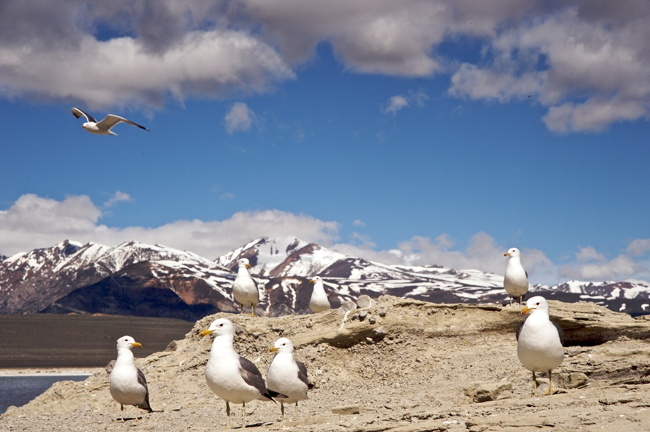
California Gulls on Paoha Island, Mono Lake.
Come to Kristie Nelson's talk on December 5th and find out what we've learned from 30 years of Gull Research!
Pete Pumphrey
Back to Top
Providing for Wintering Birds
[Click on any photo to see all in a slideshow]
By Tom & Jo Heindel
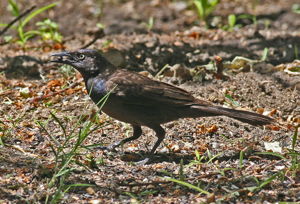
The Common Grackle is a ground feeder,
and also very rare in Inyo County!
Photo by Tom Heindel
Winter is a very stressful time for wildlife but providing cover, water, and food will insure an interesting Discovery Channel in your own backyard! Immaculate yards are less interesting since there are few places to hide from predators, at least, that is the excuse we use for letting ours go wild! A quick and easy modification is to build a pruning pile with all the branchlets that are too small to use as firewood. This can be out in an open area with no other shrubs or trees and the small birds quickly know where their safe haven is or it can be nearer your home where it is visible from inside. Homes with extensive plantings of shrubs and trees already provide lookout perches and cover but a brush pile is helpful for the birds who prefer to feed on the ground.
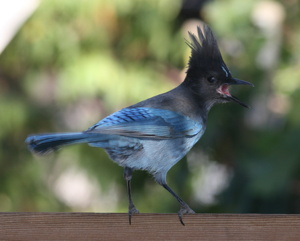
Steller's Jays prefer eating from a platform tray
Photo by Tom Heindel
As the winter gets colder, water is not always easy for birds to access in residential areas yet it is just as necessary then as the rest of the year for both drinking and bathing. Maintaining a water supply requires a little preparation and attention but is well worth the time and small cost. In order to keep water from freezing in our area, one of two methods is necessary – heating or re-circulating. A small hole in the ground, layered with plastic or rubber sheeting edged with rocks, and a small heating unit designed for outdoors placed in the water will provide open water in all but the coldest winters. Occasionally it may be necessary to pour some hot water in (after removing the thermometer). Another option is a small, ready-built pond with a small pump that will circulate the water quickly enough that, while the edges may freeze, the rest of the water will remain open. The water feature need not be large in order to attract birds. They are scouring every yard to see which ones are worth returning to for their needs. Build it and they will come!
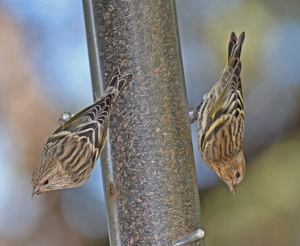
Pine Siskins at a thistle feeder
Photo by Tom Heindel
Food resources run the gamut from native fruits, berries, and seeds through commercial wildlife food. Many of the plant species used for landscaping are already providing ephemeral sustenance and cover for the birds so if your yard is well decorated with provisioning plants you are already providing some necessities for wintering birds. Many bird species prefer to eat on the ground (such as the Common Grackle pictured above) or on flat platform trays above ground level like sparrows, finches, blackbirds, (and our friend the Steller's Jay, pictured), etc. while others, such as goldfinches, siskins, etc., prefer using tube, sock, or globe feeders hung above the ground especially near shrubbery. Thistle feeders have very small holes primarily for siskins (pictured) and goldfinches but House Finches are able to get some seeds out with their larger bills and a heavy dose of persistence. Sunflower seeds are envied by many larger-billed species, such as the Evening Grosbeak pictured below, and your supply will dwindle quickly if the birds don't have to work to wedge the seeds out of the feeder. Scratch is devoured by quail, dove, and blackbirds and commercial mixed seed is eaten by species not addicted to thistle.
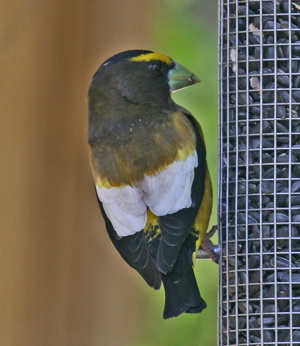
Evening Grosbeak at a sunflower seed feeder
Photo by Tom Heindel
Pine cones and a 3" diameter by 2' long log with 1" diameter and 1" deep holes, drilled down the sides can be filled with peanut butter, chunky of course, or suet, commercial or homemade. Woodpeckers (such as the rare hybrid Northern Flicker, pictured below), chickadees, nuthatches, creepers, etc. don't need perches, so suet and peanut butter feeders eliminates all species that do, although you will see a few birds that can't cling try to hover and snag a bite. Suet cakes and baskets to put them in are available at local retailers and recipes are online for homemade suet. Dried fruit and freeze-dried mealworms can be put in a variety of feeders or added to homemade suet; these supply a real energy boost during the coldest days. Remember that the variety of feeder types will increase the variety of bird species since they all have strong preferences.
While most hummingbirds escape the cold by heading south in fall, two species, Anna's and Costa's Hummingbirds are recorded in winter. We wrote a WAVE article years ago giving details on feeding hummingbirds and from that we quote "If you keep the feeder out in fall and winter there are three ways to prevent freezing: take the feeder in the house each evening and replace it early the next morning; hang it against a warm, sheltered, south-facing side of your house; or place a heat lamp near the feeder and turn it on each evening and off in the morning."
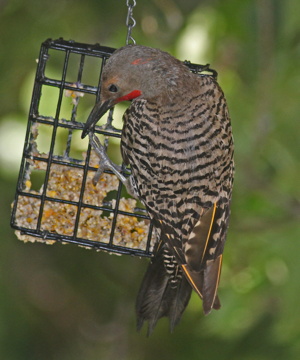
Rare Hybrid
(Red-shafted Flicker x Yellow-shafted Flicker)
at suet feeder, photo by Tom Heindel
Two modifications are that even a flood light, if close to the feeder, keeps it from freezing and some mornings are so cold (15-25°F) that we leave the light on until it is nearly 30°F since sugar water doesn't freeze until about 27°F. Not a year goes by that we don't get the question, "Doesn't leaving your nectar feeders out prevent the hummingbirds from leaving?" There is no evidence to support that belief. In fact, feeders seem to be changing the distribution of many hummingbird species both geographically, many western hummingbirds are showing up at feeders in Louisiana and other southeast locations, and temporally, Anna's Hummingbirds were not recorded in the northern Owens Valley until 1995 and have been regular, in very small numbers, every winter since. Remember that Ridgecrest is a three hour flight for a hummingbird and they have been regular winter visitors there since records were kept.
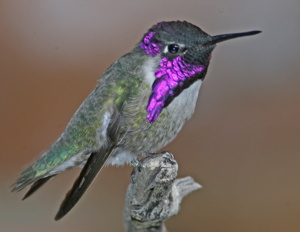
Costa's Hummingbird
Photo by Tom Heindel

Rare Hybrid Flicker at suet feeder, photo by Tom Heindel
During one snow storm we looked out at the nectar feeder hanging under the eave and watched an Anna's perch on a stick we had next to the feeder with the light shining down on his back and the snow falling just inches away. It would dart down, chug-a-lug, and back up to the warm perch where it would ruffle its feathers and crouch down so the belly feathers would cover its feet. It spent the rest of the winter with us adding its dashing red head to an otherwise colorless yard.
If you offer sustenance and solace to wintering birds, you do not get to invite which species you want to visit. You, by definition, are a non-discriminatory provider and this means that you likely will have more Eurasian Collared-Doves and European Starlings than you ever wanted. Hopefully, you might take comfort in the fact that they are a great food supply for the Sharp-shinned and Cooper's Hawks that will also utilize your yard for cover, water, and food. You will learn the various alarm calls of the species that are in your yard when one of them becomes aware of an Accipiter approaching and you might learn to identify the piles of feathers they occasionally leave behind. Winter is a whole new opportunity to learn bird behavior of species that are on the edge of survival on a good day and pushed even closer by a bad weather day!

A Cooper's Hawk may dine on the buffet of birds at your feeders! Photo by Jo Heindel

A Cooper's Hawk may dine on the buffet of birds at your feeders! Photo by Jo Heindel
Back to Top
Mystery Sparrow - Bird ID Challenge
[Click on any photo to see it larger]

Our Mystery Sparrow - first look
Photo by Debby Parker
Our Mystery Sparrow - first look -
Photo by Debby Parker
I photographed this sparrow on a gorgeous September day while gazing up into a huge yellow and orange fall colored Owens Valley Freemont cottonwood. Many birds were busy in the leaves feeding and it was fun to sort through them. Mostly Yellow-rumped warblers but a few other special ones including this sparrow below were in a huge flock northeast of Laws in humungous cottonwoods over a tiny watered ditch that came down from Silver Canyon. A favorite birding spot. When I first saw this sparrow, I was perplexed, just not able to figure out what it was so I took the best photos I could and planned on studying it more at home on the computer screen where I could really enlarge the photo.
First we see the plain breast, no streaks as in Savannah or Vesper sparrow, which are also seen in our area. These two sparrows also have pink legs, feet and at least the lower mandible of the bill as seen on our mystery sparrow but they have ventral streaks, which our bird doesn’t have, looking through the branches in photo.
Searching for identifying marks, our eyes are drawn to the face pattern, which shows a pale supercilium or eyebrow that is broader in front of the eye showing a pale lore, the auricular or cheek is warm buffy, bordered above by a warm medium-brown eyeline that extends behind the eye toward the nape, and then also below the auricular, there is a border called the moustachial stripe extending back toward the nape. Below our moustachial stripe is the pale or creamy sub-moustachial stripe that is wide, and below this is the narrow warm-brown malar stripe which borders the whitish chin and throat. Is that medium-gray we are seeing in the side of neck? Looks like it could be.
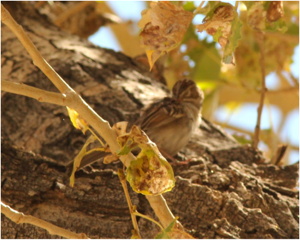
Mystery Sparrow, Photo #2
Photo by Debby Parker
Looking at photo number two, even though it’s slightly blurry, we can see the sparrow preening and showing us its crown. We can see a narrow pale central crown-stripe bordered by dark finely-streaked rusty lateral crown-stripes on each side. The eye has a subtle pale eyering.
Moving on to photo number three (below), we can see the plain breast and a buffy wash of color across the breast and down the sides and flanks slightly contrasting with a pale belly. Also again the sub-moustachial stripe is pale and clean, wrapping around to the rear of the head. We are seeing a hint of the nape which is plain, no pattern. The wing coverts show rich buffy tones and dark centers to the feathers and pale outlined. The tail tips are pointed and fresh-looking and not frayed.
As we study this sparrow in the field and in these photos, we should consider our common sparrows at this time of year. Immature White-crowned sparrows have plain breasts and pale central crown-stripes but they lack a buffy wash across the breast, their cheeks are not outlined above and below in a dark border, and distinct pale or creamy moustachial and dark malar stripe. But also important is our bird is smaller and more slender looking overall than a White-crowned sparrow which belongs to the Zonotrichia group of larger and more robust-looking sparrows. Often size is difficult to tell in the field but the Spizella group might catch our eye as being on the small side especially if we can compare one to a nearby White-crowned sparrow. But for now, let’s say we did notice it was smaller than a nearby White-crowned sparrow and then we would be led to the Spizella genus which includes Chipping, Brewer’s and Clay-colored Sparrows. Often times it is difficult to tell which one of this group we’re looking since they are so similar. Let’s first consider Chipping sparrow which is often seen in the Valley floor in the fall. First Fall Chipping sparrows, meaning they were born this spring, can be tricky as they are heavily streaked below until well into fall, unlike adult Chipping which is plain breasted. The most identifiable mark on a Chipping Sparrow is the dark or black lore which is in front of the eye. Looking at our photos, our mystery sparrow has a light lore! Also their dark or black eyeline behind the eye is darker than our bird which shows a medium-brown eyeline. The face pattern is slightly different. Lastly Chipping sparrows have a gray rump which contrasts with the brown back but our photos don’t show us the rump, nor was it seen it in the field, so we can’t use it.

Our Mystery Sparrow - 3rd photo
Photo by Debby Parker
Moving on to the next Spizella, we consider Brewer’s sparrow. This sparrow is similar in many ways to our photos above but while Brewer’s can show a dull beginning of a central crown-stripe, they lack an obvious complete central crown-stripe, which extends across the crown which our mystery bird has. Brewer’s sparrows are more plain-faced, lacking the pronounced dark borders to the auricular as seen in above photos and while they lack a dark lore as in Chipping sparrow, their supercilium is not creamy white as in our mystery sparrow photos. They too have an eyering which is thin and often is one of the main marks that stand out in their plain grayish face. Lastly they lack the buffy wash across the breast as seen in our mystery sparrow photo.
American Tree Sparrow is also a Spizella and rare in our area and a great find. While they have a plain breast, they lack a buffy wash and have a black spot in the center of their breast instead. Their crown is noticeably rufous as is their eyeline, which our mystery sparrow didn’t have.
We are now left with Clay-colored sparrow which seems to fit our photo very well. Our sparrow has the buffy wash across the plain breast indicative of a Clay-colored, a distinctive and contrasty patterned face, which is not plain and shows a creamy supercilium, a warm-colored buffy auricular bordered by brown edges and a strong pale central crown-stripe. The brown sub-moustachial stripe outlines the broad pale moustachial stripe above and below this broad pale stripe is the dark malar stripe easily seen. The malar stripe outlines the white chin. Is our bird a first fall bird? The field guides note that first fall birds will be buffier than adults. Since this is relative it’s hard to say. They also say that first fall birds might show some streaks in the flanks which aren’t seen in the photos. Since this is a rare sparrow in the west, more study is needed to figure out whether it’s an adult or first fall bird but at least we know its name! In conclusion, this is a Clay-colored sparrow, a treat to find indeed.
By Debby Parker
Back to Top
Reports
Field Trip Report: Finkbeiner Forest, Bishop, September 29th
Highlights of a morning outing in woods off Brockman Lane included numerous Orange-crowned Warblers and White-crowned Sparrows. Three or four Downy Woodpeckers worked the branches. A small flock of Bushtits swept through. The last of our nearly seventeen species was a Roadrunner which crossed the path as we neared our car. But where were the birders this fine day?
Larry Nahm
Field Trip Report: Rock Creek, October 27th
It is normal at this time of the year for the mornings to be quite chilly at Rock
Creek and this was no exception. It was below freezing at 9am but once in the
sun we were good. We also had the unusual experience of walking much of the
trail on snow and ice left by the preceding snow storm. We have birded this trail in drizzling rain before but never have had snow.
As usual, the birds did not make their appearance until it had warmed
sufficiently and that was when we reached the upper campground. At that
point we began seeing small flocks of Mountain Chickadees and Dark-Eyed
Juncos. A lone Steller's Jay checked us out at the campground and we heard
Clark's Nutcrackers in the distance.
The highlight was watching a juvenile American Dipper across the creek which
was not at all bothered by us. We had the excellent looks getting clear views of
the bill, eye, head, feathers with their edging, as well as legs while it went about
its business.
We stopped for lunch at the pond below Rock Creek Lake which was pleasant
because the sun kept us warm by then. There was a Belted Kingfisher across the pond and Red-breasted Nuthatches in the background.
After lunch, we continued up to Rock Creek Lake with the snow and ice becoming
considerably deeper. We elected to walk back on the road because of the ice that
was on the switchbacks.
Noticeably absent were the American Robin, Brown Creeper and Hermit Thrush
although we looked and looked. We did hear several Townsend's Solitaires
on the return trip as well as seeing a few wildflowers still in bloom - particularly
Daisies and Buckwheat (Eriogonum Umbellatum).
Bill Mitchel
Taking Care of Business
Welcome New Members, and Thank You Renewing Members!
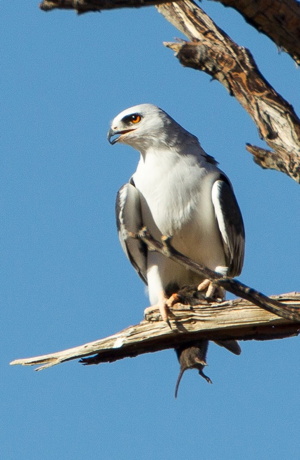
White-tailed Kite, with a vole for dinner
Photographed in Bishop by Todd Vogel
From the Eastern Sierra Birds Google Group
Brian Adkins
|
Peter Hoijer
|
Lynn Butler
|
David Humes
|
Lynn Galloway
|
Sandra Kerridge
|
Warren J. Allsup
|
Roberta Lagomarsini and Peter Pumphrey
|
Terri Dean
|
Brock Thoman
|
Sally Gaines
|
Mr & Mrs John & Nancy Walter
|
Dora & Bill Hayes
|
Ann Zack |
| Ann Hoffmann |
|
- Brian Adkins
- Lynn Butler
- Lynn Galloway
- Warren J. Allsup
- Terri Dean
- Sally Gaines
- Dora & Bill Hayes
- Ann Hoffmann
- Peter Hoijer
- David Humes
- Sandra Kerridge
- Roberta Lagomarsini and Peter Pumphrey
- Brock Thoman
- Mr. & Mrs. John & Nancy Walter
- Ann Zack
Your membership donations help keep this chapter alive. We get 8-10 renewing members a month, and from 3-5 new members. Your membership dues make it possible for us to offer and support great educational and recreational events throughout the eastern Sierra. Thank you!
If you would like to join and help support Eastern Sierra Audubon, there are two ways you can do it:
- Join as a National Audubon Society Member, designating ESAS as your chapter affiliation. Includes Audubon Magazine subscription. This is $20 for the first year, and goes up to $35 annually thereafter.
- Join as an ESAS Chapter-only member for $20 per year. Now that we do the newsletter online, you no longer need to join to receive it, but your chapter membership is a way to give back, and show your appreciation for all that ESAS does, and to help support our many programs. You may mail membership with your contact information and check for $20 to Eastern Sierra Audubon Society (ESAS), P.O. Box 624, Bishop, CA 93515
Click Here for a membership form to join or renew!
Join National Audubon - your zip code will associate you with the chapter nearest you.
Back to Top
Thank You for your Donations
Eastern Sierra Audubon would like to extend special thanks for donations made to our chapter!
Thank you to member and Birds in the Classroom volunteer Margaret Phelps for your gift, and thank you to Andrea Jones and the Conservation Committee of Sea and Sage Audubon, who gave in support of the work on the Owens Lake Important Bird Area, as result of a presentation on California's Important Bird Areas by Andrea Jones given at their chapter's 4th Tuesday Conservation Lecture.
Back to Top
How You Can Help ESAS: Four R’s (and a V)
Renew your membership (or join): The money from your membership dues is what helps us bring great evening programs, special events, educational programs, trips, this website, and more to the community - we need your support!
Recycle at Manor Market and tell them to donate the money to Eastern Sierra Audubon.
Respect property and get permission to bird on private or restricted access property.
Repeat: Spread the word about programs and events, encourage others to join and participate.
Volunteer: Come to a board meeting and consider volunteering for an open board position! We welcome new board members, and we also always need volunteers for Birds in the Classroom, participants in bird counts, Bird-A-Thons, etc.
Back to Top
Message from the Editor
Our next newsletter deadline will be December 20th for the
January-February issue (a little early due to the holidays - if you have a late article or event, just let me know, though, and I will try to get it in). We will send a reminder when the newsletter is online, and for any other timely events.
We try to send out no more
than one email each month to remind you of upcoming events - if you are not
on our email list, please
add yourself so you don’t miss anything! If you send items to the newsletter
editor by the last week of any month, we’ll make sure they get included in
the next issue.
Speaking of sending in items for the newsletter...
All of our content is supplied by our amazing members... if you have anything to share for the newsletter, whether an article, a news item, event, update, correction, poem, essay, artwork, photo, field trip report, neat birding experience, letter, etc, please send it, along with any comments or suggestions, to the newsletter
editor. We’d love to hear from you!
You may send items for inclusion in the newsletter at any time, but please
send any timely items to arrive before the first of the month, so they can
be included in the monthly email update.
Thanks for reading, and happy birding!
Maggie Wolfe Riley, Newsletter Editor
Back to Top
About Eastern Sierra Audubon
Current Board Members
Membership
Main Calendar of Events
Next Board Meeting:
Wednesday, November 7, 6pm, at the Eastern Sierra Land Trust office on 176 Home Street
Calendar for November and December
Back to Top
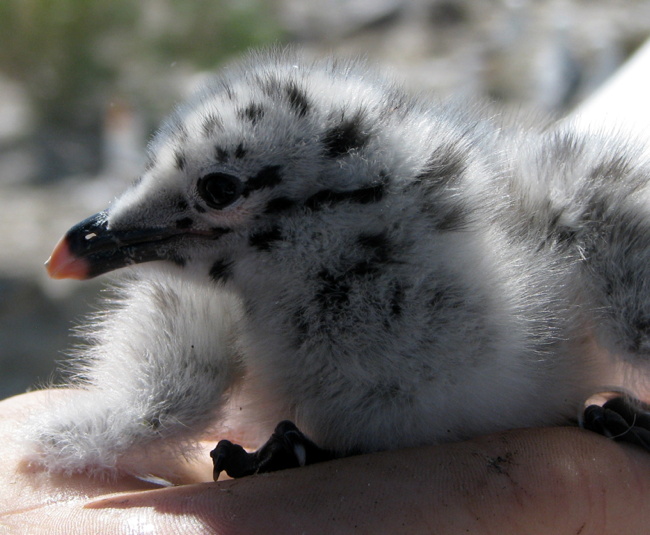
For more warm fuzzies, come to our December 5th program:
30 years of gull research on Mono Lake, with Kristie Nelson!
Back to Top



